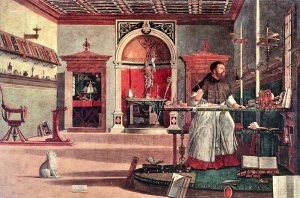We support our Publishers and Content Creators. You can view this story on their website by CLICKING HERE.
 Literature is important because it takes us beyond the facts to the truth. It shows us who we are as human beings and as human persons. We could go even further by insisting that literature is not merely important but necessary. Without literature or, more specifically, without the ability to see literarily, we will be blind; we will not be able to see or understand who we are or what the cosmos is. This was encapsulated paradoxically by G.K. Chesterton. “Not facts first,” said Chesterton. “Truth first.” His point was that facts are merely physical whereas truth is metaphysical. Facts are those things that are quantifiable, measurable materially. Truth is not quantifiable; it cannot be measured materially. Goodness cannot be weighed on a scale; truth cannot be fathomed in terms of physical depth or breadth; beauty cannot be heated in a test tube. Metaphysics cannot be consigned to physics, nor can it be confined by physics. It transcends all physical confinement. Those who seek the truth, the whole truth and nothing but the truth will never find it in the facts and nothing but the facts. Not facts first; truth first!
Literature is important because it takes us beyond the facts to the truth. It shows us who we are as human beings and as human persons. We could go even further by insisting that literature is not merely important but necessary. Without literature or, more specifically, without the ability to see literarily, we will be blind; we will not be able to see or understand who we are or what the cosmos is. This was encapsulated paradoxically by G.K. Chesterton. “Not facts first,” said Chesterton. “Truth first.” His point was that facts are merely physical whereas truth is metaphysical. Facts are those things that are quantifiable, measurable materially. Truth is not quantifiable; it cannot be measured materially. Goodness cannot be weighed on a scale; truth cannot be fathomed in terms of physical depth or breadth; beauty cannot be heated in a test tube. Metaphysics cannot be consigned to physics, nor can it be confined by physics. It transcends all physical confinement. Those who seek the truth, the whole truth and nothing but the truth will never find it in the facts and nothing but the facts. Not facts first; truth first!
But this brings us to a further paradox. As Aristotle and Aquinas remind us, we can only access metaphysical reality through our physical senses. We must perceive the facts and nothing but the facts in order to attain the truth and nothing but the truth. Not truth first; facts first! Truth is the goal and the purpose of perception but the facts are the necessary means by which the truth is accessed. The last shall indeed be first, and the first last.
This paradox was addressed by Augustine in De Doctrina Christiana in his insistence that truth can only be attained through the reading of the facts literarily, not merely literally. We need to see things as things but we also need to see them as things that signify other things. An animal track is physically an indentation in the mud but it signifies the recent presence of an animal walking in a certain direction. This is what Augustine calls a “natural sign”, a physical thing that signifies something other than itself. Smoke as a signifier of fire is another example he gives of a natural sign. At the most basic level, a thing that speaks of another thing is an allegory. The word allegory comes from the juxtaposition of two Greek words: allos (another, different) and agoreuein (speak openly). Every natural sign is, therefore, an allegory.
Augustine distinguishes between natural signs and what he calls “conventional signs”. The most commonly used conventional signs are words. These are things that the human imagination has made which enable a person to think about other things. If one speaks a certain language (English), the monosyllabic noise or three-letter word, dog, will bring to mind a four-legged canine mammal. Each word is, therefore, an allegory. It is a thing which speaks of something else. These invented signs can point to physical things but they also enable the mind to think of metaphysical things. If the three letters that combine to make the word dog are reversed, we get god or God.
The ubiquitous use of signs (words) in human thought and speech means that we exist at every moment not merely in the literal facts but in the literary reading of the literal facts. Our very lives exist not merely as literal facts but as literary truths. Our actions are read by others. We learn from others and they learn from us. They follow our example, for good or ill. They reap the benefits or suffer the consequences. They learn the lessons that these consequences teach. We are, therefore, living, breathing allegories. We are signs that convey meaning to others. Each of our lives is a story which others read and which we are meant to learn to read ourselves, seeing the significance of what we have done and in what we have failed to do. But each of our lives is part of a greater story in which our lives are interwoven with the lives of countless others, both living and dead. Our story is part of that greater story called history which, if seen in the light of the truth that transcends and transfigures the mere facts, is understood providentially as His Story.
His Story is told in terms of salvation history, which is itself told in Sacred Scripture. In the Holy Bible as in everyday life, we need to get beyond the facts to the truth. The Bible, like life, must not be read merely literally but literarily. This is why Augustine proceeds from the discussion of natural and conventional signs to a discussion of reading Scripture allegorically and why Aquinas, following Augustine’s lead, speaks of there being no fewer than three distinct levels of allegorical meaning in the Bible, beyond the merely literal level. We must understand the literal meaning, as we must know the facts, but only in order to transcend the literal and the factual with the literary light of truth.
The Imaginative Conservative applies the principle of appreciation to the discussion of culture and politics—we approach dialogue with magnanimity rather than with mere civility. Will you help us remain a refreshing oasis in the increasingly contentious arena of modern discourse? Please consider donating now.
The featured image is St. Augustine in His Study” (1502) by Vittore Carpaccio, and is in the public domain, courtesy of Wikimedia Commons.
Share This Story, Choose Your Platform!
Go to Top

 Conservative
Conservative  Search
Search Trending
Trending Current News
Current News 






